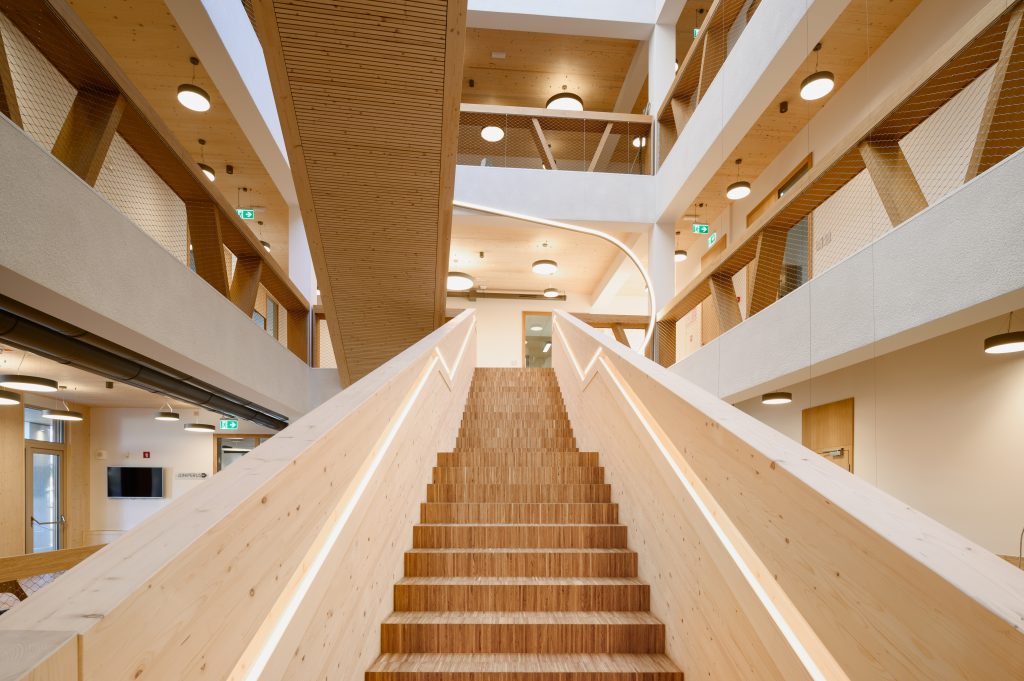
January 7, 2026

The WOOLF research and development project was selected in a 2018 public tender by the Republic of Slovenia’s Ministry of Education, Science and Sport and the European Regional Development Fund, European Commission (ERDF), entitled “Promoting the implementation of R&D projects (TRL 3-6).” Over the next three years, a multidisciplinary consortium in the forest-timber value chain consisting of four research organizations, including InnoRenew CoE, and four business organizations focused on challenges within the Smart Buildings and Home, including the Wood Chain priority area within the Slovenian Smart Strategy Specializations (S4).
The project’s main idea was based on the development of products and advanced technologies to enable the use of standard and alternative wood species and reclaimed wood, predicting the life of wood and wood products and their intelligent management, operation and use in multistorey modular wood construction. For this purpose, the project consortium developed wooden construction and window systems that enable the construction of multistorey modular wooden buildings and introduced newly developed sensor technology.
The project’s final goal was the development of four prototypes for products and services, which are combined in a hybrid wooden-steel modular building:
In relation to the newly developed smart ICT system, it will be possible to monitor the quality of wood and wooden products in real-time and predict their lifespan in the future.
InnoRenew CoE’s main tasks in the WOOLF project were to develop the structural system and construction details of a multistorey hybrid wooden-steel modular construction and the socio-economic analysis (S-LCA) of materials and product prototypes developed within the project.
In the initial phase of the development of structural assemblies’ individual elements, we performed a preliminary study with numerical simulations of the hybrid wooden-steel load-bearing structural elements’ mechanical behaviour. We examined the behaviour of assemblies such as frames, walls, ceilings and floors. In the next step, we examined various possibilities of individual structural elements’ joints from the point of view of strength and stiffness, the influence of aging and the possible impact of fire. Emphasis was given to the development of joints that enable fast and reliable connections between individual structural elements and solutions that enable optimal production speed in the factory. Additionally, we included the development and design of mounting locations for “WOrMS” sensor units (Figure 1).
Figure 1: Prototyping of M-Sora windows from reclaimed wood and installation of “WOrMS” sensor unit.
Then we performed experimental investigations in the ZAG laboratories on individual selected hybrid wooden-steel lateral load resisting systems exposed to vertical loads and horizontal loads such as earthquakes and wind. The investigations were carried out by measuring forces and deformations and monitoring the failure mechanisms on individual variations of the specimens (Figure 2). The prepared samples were tested based on several different parameters and replicates so that in addition to individual mechanical properties, we also determined their statistical scatter. The second phase of the experiments focused on structural elements’ behaviour in the event of a fire (Figure 3).
Figure 2: Experimental investigations of a hybrid system of steel frames with wooden shear walls at ZAG institute.
Figure 3: Fire investigations of shear walls at ZAG.
In the second phase of the project, we performed verification and validation of the structural elements’ preliminary numerical models with the results of experimental investigations. Based on the selected optimal solutions, together with project partners, we made detailed drawings of structural assemblies for prototyping. Then, within the entire consortium, we made a prototype of individual structural assemblies for modular construction with wood (Figure 4, 5). We built the developed prototypes of the “WOrMS” IoT sensor unit into the structural assemblies’ manufactured prototypes, which enable monitoring of key assembly parameters even after the project’s completion.
As part of the activities in the initial phase of the project related to the life cycle of materials and products, we analyzed the impacts and possibilities of using new wood species, less-used tree species and reclaimed wood. Namely, this will reduce the pressure of logging more economically interesting and commonly used wood species. As the facilities for the primary production of wood products are predominantly located in rural areas, this will also positively impact harmonious regional development and social cohesion, which is an important priority for the EU. In the following, we analyzed the impacts of the developed innovative sustainable solutions in modular construction. New wooden modular units are changing the paradigm of modular construction due to the shift towards sustainable materials and the possibility of multistorey buildings, eliminating the current negative connotation and introducing new approaches to solving socio-economic crises (refugees) and natural disasters (earthquakes relocations).
Figure 4: Installation of sensors on a prototype hybrid modular unit using lignocellulosic materials.
Figure 5: Final look of the prototype hybrid modular unit — evaluation platform.
Dr. Igor Gavrić, InnoRenew CoE researcher